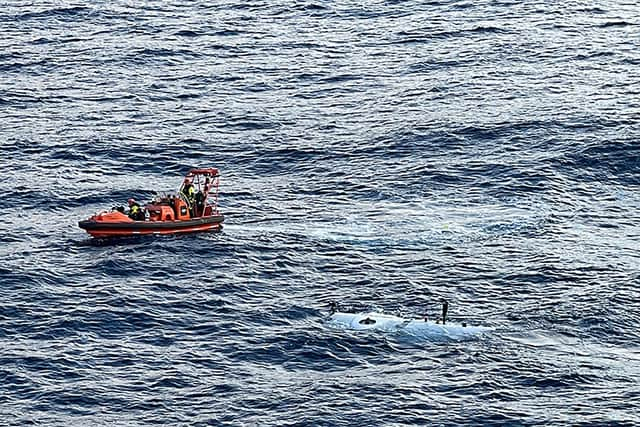Thoughts now turning 'to the families left behind' - ex-Royal Navy crewman on Titanic vessel loss
and live on Freeview channel 276
Ian Shantwell, secretary of the mid-Antrim branch of the Royal Naval Association, said getting stuck and losing all contact with the wider world is “about the worst situation” a sailor could imagine.
He was speaking last night as the odds of finding the five occupants of the tiny submersible grew longer and longer; some experts had estimated that the vessel’s supply of oxygen would only last until Thursday morning.
Advertisement
Hide AdAdvertisement
Hide AdThe Titan’s trip to the seafloor to visit the remains of the Titanic is one that has been made countless times before by adventurers from across the world, some of whom have been recounting the nerve-wracking problems they faced while deep beneath the sea over the last several days.
Among them has been Mike McKimm, a former BBC environment correspondent, and one of at least two Ulstermen who have made the journey – the other being former Harland and Wolff worker David Livingstone.
Mr Shantwell himself, originally from England, used to be a member of the Fleet Air Arm – basically the Royal Navy’s own RAF.
He recalls being scrambled to the runway in the late 1950s, along with all other submarine-hunting personnel in the area, to search for a missing sub.
Advertisement
Hide AdAdvertisement
Hide AdAs it turns out, that submarine had been fine: it had merely missed its “call in” – the pre-arranged time when it would send a signal to base – causing a panic.


"Obviously we’re anxious for the guys in there, all five of them,” he said of the current Titan crisis.
"But going by what they said on the TV, they’ve had it.”
Giving an indication of just how hard it is to find anything in the open ocean, he said even if the little submersible had somehow made it above the waves for a time, there is no absolute guarantee it would be spotted.
"It's very hard to spot something on the surface of the sea, even if there's only mild weather," he said.
Advertisement
Hide AdAdvertisement
Hide Ad"And you're talking about 400 miles out into the Atlantic – and the North Atlantic, at that.
"When I've been out there, [the weather] ain't been very happy."
He said that "I imagine it's the point of view of nearly everyone" that vanishing without a trace – no comms, no propulsion – is a mariner’s worst fear.
"It's the worst situation you could be in, isn't it?
"I know that everybody's doing everything they can to try and find them. But I think the time has passed now.
Advertisement
Hide AdAdvertisement
Hide Ad"Everyone thinks of the families that are left behind. That's the main concern now."
In the wake of the disappearance, ex-BBC Northern Ireland reporter Mike McKimm was recounting his own experiences deep under the waves.
He had reportedly been on a Russian-led submersible which lost power for 20 minutes during an ocean dive in 2005 to visit the Titanic wreck.
"Nobody knew what was going on and I just thought: 'Wow, this is going to be it'," he said.
Advertisement
Hide AdAdvertisement
Hide Ad"In those 20 minutes you've a lot to think about and you realise just how dangerous it all is, diving at that depth is a very dangerous past time, the risks are very, very high," he said.
He also described the deep ocean as “blacker than you could ever imagine".
According to a piece in the Irish News in 2016, former shipyard worker David Livingstone “became the first person from Ireland to make the two-and-a-half hour journey down 12,500ft to the wreck in a special submersible” in 1996.
Mr Livingstone died in 2016, aged 73, and his funeral was at St Mark’s Church of Ireland in Newtownards.
Advertisement
Hide AdAdvertisement
Hide AdMr Livingstone came from Milford and was educated at Royal School Armagh from where he left to join the shipyard as an apprentice in the drawing office in the 1960s.
By the mid-1990s he was recognised as a world authority on various aspects of shipping design.
The Irish News reported in 2016: “Mr Livingstone and two others with him nearly came to grief 12,500ft down. Their submersible entered Titanic’s exposed engine room but a water current prevented them from leaving.
“They eventually escaped using the submersible’s mechanical arms.”